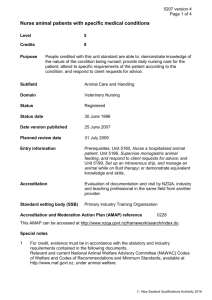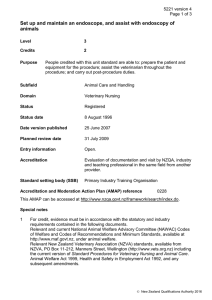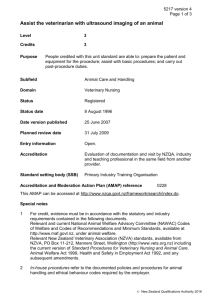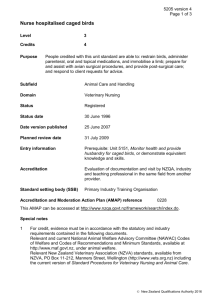Nurse an intensive care animal patient
advertisement
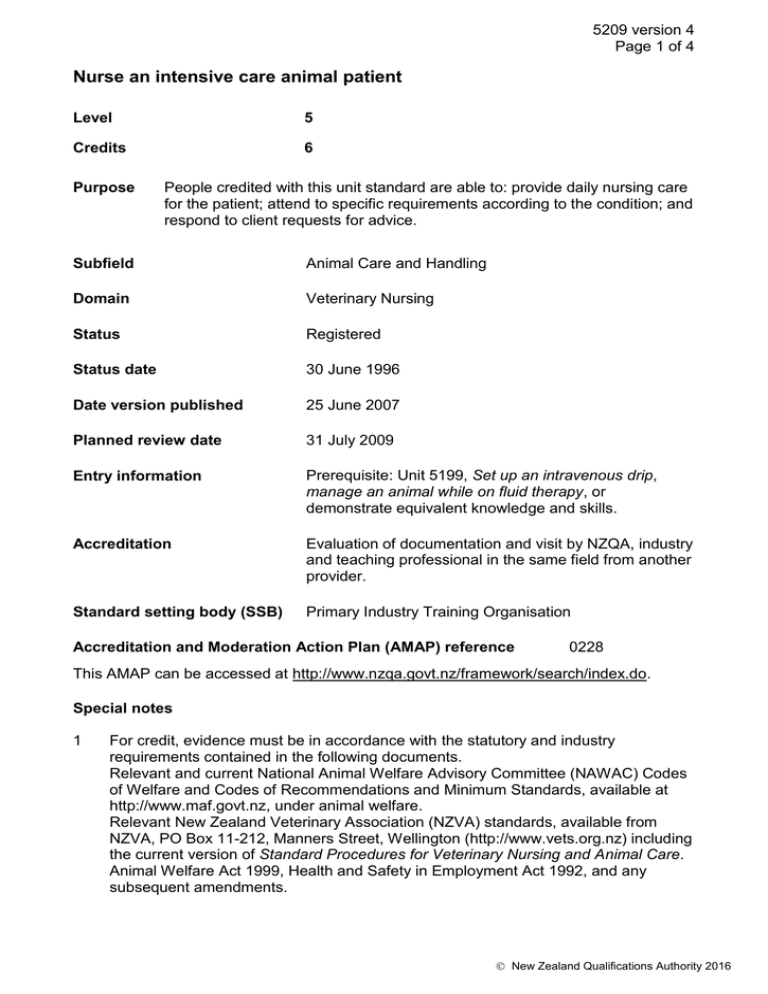
5209 version 4 Page 1 of 4 Nurse an intensive care animal patient Level 5 Credits 6 Purpose People credited with this unit standard are able to: provide daily nursing care for the patient; attend to specific requirements according to the condition; and respond to client requests for advice. Subfield Animal Care and Handling Domain Veterinary Nursing Status Registered Status date 30 June 1996 Date version published 25 June 2007 Planned review date 31 July 2009 Entry information Prerequisite: Unit 5199, Set up an intravenous drip, manage an animal while on fluid therapy, or demonstrate equivalent knowledge and skills. Accreditation Evaluation of documentation and visit by NZQA, industry and teaching professional in the same field from another provider. Standard setting body (SSB) Primary Industry Training Organisation Accreditation and Moderation Action Plan (AMAP) reference 0228 This AMAP can be accessed at http://www.nzqa.govt.nz/framework/search/index.do. Special notes 1 For credit, evidence must be in accordance with the statutory and industry requirements contained in the following documents. Relevant and current National Animal Welfare Advisory Committee (NAWAC) Codes of Welfare and Codes of Recommendations and Minimum Standards, available at http://www.maf.govt.nz, under animal welfare. Relevant New Zealand Veterinary Association (NZVA) standards, available from NZVA, PO Box 11-212, Manners Street, Wellington (http://www.vets.org.nz) including the current version of Standard Procedures for Veterinary Nursing and Animal Care. Animal Welfare Act 1999, Health and Safety in Employment Act 1992, and any subsequent amendments. New Zealand Qualifications Authority 2016 5209 version 4 Page 2 of 4 2 In-house procedures refer to the documented policies and procedures for animal handling and ethical behaviour codes required by the employer. 3 Underpinning Knowledge The following areas of knowledge underpin performance of the elements in this unit standard: Types of medication used, effects, and possible side effects Basic caloric requirements, importance of dietary intake Quantity and frequency of feeding Management of pressure sores Side effects of medication and contra-indications When intervention is vital. Elements and performance criteria Element 1 Provide daily nursing care for the patient. Performance criteria 1.1 Patient is provided with an appropriate diet and fed, according to the individual and the condition, as directed by the veterinarian. 1.2 Bedding or support to assist recovery is provided and maintained in a hygienic state. 1.3 Patient is handled, turned, and positioned in a manner which enhances recovery and avoids stress, injury to animal or people, or exacerbation of the condition. 1.4 Patient is monitored, records are maintained, and observations are recorded and reported to the veterinarian according to practice protocol. 1.5 General care is provided, according to the condition, to maintain the animal in a comfortable state. Range grooming, bathing, cleaning of kennel or ward, environmental temperature, physiotherapy, psychological support, environmental enrichment, massage. New Zealand Qualifications Authority 2016 5209 version 4 Page 3 of 4 Element 2 Attend to specific requirements according to the condition. Performance criteria 2.1 Medication is administered as directed by the veterinarian. 2.2 Measures are implemented to prevent interference by animal of dressings, bandages, and equipment without compromising the success of treatment. 2.3 Invasive equipment is set up and maintained according to the condition and as directed by the veterinarian. Range 2.4 intravenous cannula, urinary catheter, foley catheter, chest drain, oxygen therapy tent, nasogastric tube, fluid therapy, tracheotomy tube, gastrotomy tube, peritoneal drain, pharyngostomy tube. Emergencies are recognised and action taken according to the circumstances. Range report to the veterinarian, resuscitate. Element 3 Respond to client requests for advice. Performance criteria 3.1 General enquiries from clients are assessed to determine most suitable person to deal with enquiry. 3.2 Advice within parameters specified by the practice and within the capability of self is provided in a manner which is tactful and at a level of understanding appropriate for the client. Range 3.3 updates on patient's progress, counselling, grieving client. Need for referral to a specialist is assessed in accordance with in-house procedures. Please note Providers must be accredited by NZQA, or an inter-institutional body with delegated authority for quality assurance, before they can report credits from assessment against unit standards or deliver courses of study leading to that assessment. Industry Training Organisations must be accredited by NZQA before they can register credits from assessment against unit standards. Accredited providers and Industry Training Organisations assessing against unit standards must engage with the moderation system that applies to those standards. New Zealand Qualifications Authority 2016 5209 version 4 Page 4 of 4 Accreditation requirements and an outline of the moderation system that applies to this standard are outlined in the Accreditation and Moderation Action Plan (AMAP). The AMAP also includes useful information about special requirements for organisations wishing to develop education and training programmes, such as minimum qualifications for tutors and assessors, and special resource requirements. Comments on this unit standard Please contact the Primary Industry Training Organisation standards@primaryito.ac.nz if you wish to suggest changes to the content of this unit standard. New Zealand Qualifications Authority 2016
